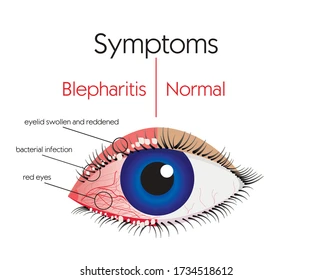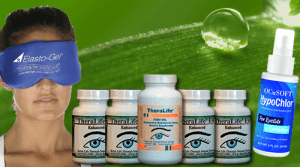Blepharitis home treatment
Blepharitis can affect a person’s eyelid, causing it to become droopy.
The lashes can become sticky or clumpy. This occurs from inflammation of the eyelid base.
It’s easy to treat symptoms by using blepharitis home treatment.
The article explains the underlying cause and treatment of blepharitis and the ways of preventative care.
Blepharitis is commonly referred to as chronic blepharitis if it is a severe disease.
Best Blepharitis Treatment From TheraLife
At a glance: Blepharitis
Symptoms: red, itchy or burned eyes or eyelids, rashes in eyes or lashes.
What is blepharitis?
Blepharitis means a chronic form of eyelid inflammation.
It is also commonly called lid margin disease because it affects only the edges of your eyelids.
It can happen either when certain skin conditions cause irritation or when bacteria results in infection, or a combination.
Blepharitic eye conditions can cause redness, swelling and irritation of eyelids and swollen eyelids. This may cause scaly flakes on the eyes.
Having blephalitis is unpleasant. But the infection is not contagious and usually causes no serious eye problems for long.
Normally bripharitis can be treated through regular cleansing of eyelash surfaces and keeping them clean and dry.
Blepharitis does not usually fade but can be controlled easily, especially if you exercise blepharitis home treatment.
Tell your doctor what causes your blepharitis and how to treat the problem.
Tell me the best way to check for blepharitis?
Your eyes doctor may check for blepharitis through a physical examination.
During an eye test your doctor will examine your face, cheekbones, and eyelashes.
They might use bright illumination or special magnifier instruments to magnify things.
Symptoms
In some cases symptoms can be cleared and returned within several weeks. It is called chronic blepharitis, which is hard to control.
Blepharitis is typically worse in the morning.
Symptoms of blepharitis include:
- Watery eyes
- Red eyes
- A gritty, burning or stinging sensation in the eyes
- Eyelids that appear greasy
- Itchy eyelids
- Red, swollen eyelids
- Flaking of the skin around the eyes
- Crusted eyelashes
- Eyelid sticking
- More frequent blinking
- Sensitivity to light
- Blurred vision that usually improves with blinking
- Tears that are foamy or have small bubbles in them
Symptoms of blepharitis may have gritty or burning eye irritations or itchy red / swollen eyes or dry eyes.
Usually blepharitis causes only slight itchiness.
It is also susceptible to worsening of vision and eye irritations.
When irritated areas get touched or rubbed there are also possible secondary infections.
Blepharitis is a precursor of Meibomian gland dysfunction, rather than the gland dysfunction causing blepharitis.
Best Blepharitis Treatment From TheraLife
Tell me the type of blepharitis?
Anterior.
Blepharitis of the upper ear is a condition affecting the outer brows of your eyes, where your eyelashes hang over your eyelids.
Anterior blepharitis occurs when the eyelid’s front exterior, where eyelashes emerge, is red and swollen.
This usually occurs due to bacteria or dandruff of the hair and brows. Some allergies can also be caused by mites (tiny parasites).
Posterior
Posture blepharitis affects your eye’s outer edge. Meibomian gland dysfunction is from posterior blepharitis.
Posterior blepharitis can also develop as a result of other skin conditions, such as rosacea and scalp dandruff.
Causes & risk factors
Blepharitis happens when bacteria accumulate under eyelash bases. If you are allergic to bacteria it is normal, but it’s also dangerous. Blepharitis is characterized mainly by oil glands that are clogged and irritation of the eyes.
Blepharitis can be caused by: a type of bacteria that lives on the skin a skin condition, such as seborrhoeic dermatitis the glands inside the eyelids not producing enough oil.
It is a common eye disorder caused by either bacteria or a skin condition, such as dandruff of the scalp or rosacea.
There are a number of possible causes of blepharitis.
Bacteria
They include: an inflammatory reaction to bacteria that normally live on eyelids seborrhoeic dermatitis or rosacea parasites:
Anterior blepharitis is typically caused by bacteria (staphylococcal blepharitis) or hair follicle or eyebrow rash ( seborrhic blepharitis ).
The bacteria are often present within the face and lids but can cause infections.
Allergies
In some instances allergies or mite infections can lead to anterior blepharitis.
Demodex
Demodex eyelash mites infection with the herpes simplex virus (HSV) People who have dandruff are more likely to develop blepharitis. Keeping the dandruff under control can help reduce the symptoms.
Meibomian Gland Dysfunction
Another possible cause is dysfunction of the Meibomian glands on the rim of the eyelids.
Posteriorial blepharitis is an abnormal gland in the eyelid that produces excessive oil (“meibomian blepharitis”). It gives bacteria the opportunity to thrive in the environment.
Posterior blepharitis is often caused from other skin ailments – rosacea and dandruff.
Diagnosis
Blepharitis can be detected during a thorough eye examination.
An eye doctor may determine the severity of Blepharitis by looking closely at eye margins and their margins.
Treatments
You’ll also learn about home remedies, over-the-counter (OTC) treatments, and prescription medications that treat chronic eyelid inflammation.
Over-the-Counter treatment
Eyelid wash is available for treatment if needed. It can also reduce eye irritation and reduce the appearance of eyelid blepharitis.
Prescriptions
In cases in which at-home treatment does not relieve symptoms, consult a specialist. It can be prescribed to blepharitis patients to treat it.
Blepharitis Home Treatment
In most instances, Blepharitis can be cured using home remedies or medications.
Some people require medication for a specific condition.
Things you can do to treat and prevent blepharitis.
Do clean your eyelids twice a day to start with and then once a day as your symptoms improve continue to clean your eyes, even if your symptoms clear up.
Do not wear contact lenses while you have symptoms.
Do not use eye makeup, especially eyeliner and mascara, while you have symptoms
How to clean your eyes
Soak a clean flannel or cotton wool in warm water and place it on your closed eyelid for 5 to 10 minutes. Gently massage your eyelids for around 30 seconds. Clean your eyelids using cotton wool or a cotton bud.
Gently wipe along the edge of your eyelids to remove any flakes or crusts. Gently rub the cloth or cotton swab back and forth, focusing on the area where your eyelashes meet your eyelids. Rinse your eye with clean water. Repeat these steps on your other eye using a new cloth or cotton swab.
Some people recommend baby shampoo – it does not work. Baby shampoo is a detergent which cleans up the bacteria, the allows the bacteria to re-attach to the eyelids. Setting up a re-infection cycle.
Warm water wash cloth does not retain heat long enough. We recommend a warm compress made of gel, microbeads for better heat retention.
We highly recommend eyelid cleanser for cleaning eyelids. e.g. Avenova.
During flare-ups
It is a good idea to stop wearing eye makeup. Makeup makes it challenging to keep your eyelids clean and free of debris.
Then gently scrub the eyelids with an over-the-counter lid cleansing product.
In cases involving bacterial infection, an antibiotic may be prescribed.
Helpful tips.
People with blepharitis might find the following blepharitis home treatment helpful:
If the glands in the eyelids are blocked, massage the eyelids to clean out oil accumulated in the eyelid glands.
Gently wipe along the edge of your eyelids to remove any flakes or crusts.
In addition to home treatment, people with the eyelid inflammation should avoid using cosmetics such as eyeliner, mascara, and other makeup around the eyes.
If you have dandruff, it can contribute to your blepharitis. Ask your doctor for a dandruff shampoo. It can help relieve some of your symptoms
Management- blepharitis home treatment
Management of blepharitis home treatment involves: warm compresses, to loosen crusts lid cleansing, to remove crusts massage, to express the small oil glands of the eyelids.
Prevention
Prevention In many cases, good hygiene can help control blepharitis. Valuable advises for blepharitis home treatment.
This includes frequently washing the scalp and face, using warm compresses to soak the eyelids and scrubbing the eyelids.
When a bacterial infection is causing or accompanies blepharitis, antibiotics and other medications may be prescribed.
Warm compresses can help soften crust and loosen oily debris. Follow these steps: Wet a clean washcloth in warm (not hot) water . Wring it out and place it over your closed eyelids for 5 minutes. Wet it again as necessary to keep it warm.
References
Show Sources SOURCES: American Optometric Association: “Blepharitis.” National Eye Institute: “Blepharitis.” Merck Manual Consumer Version: “Blepharitis.” American Academy of Ophthalmology: “Blepharitis Treatment.” UpToDate: “Blepharitis.”





